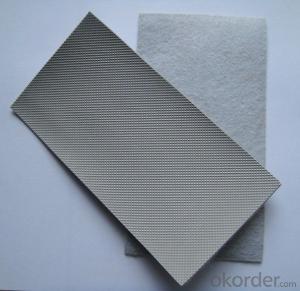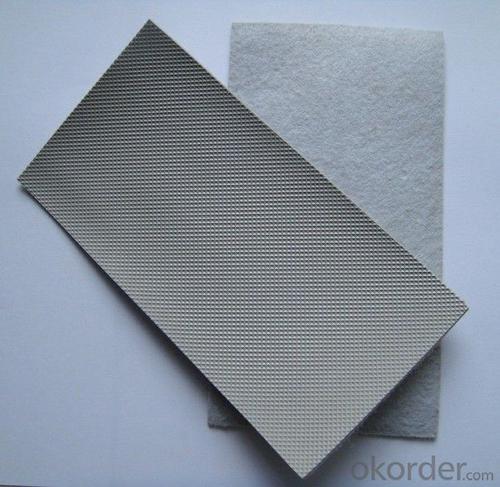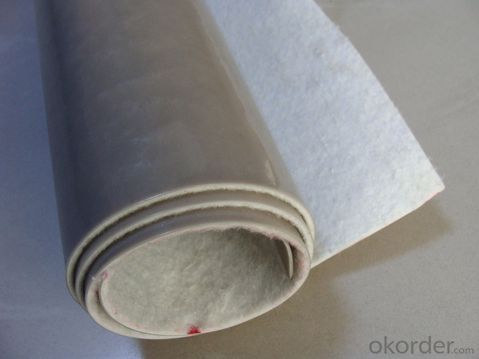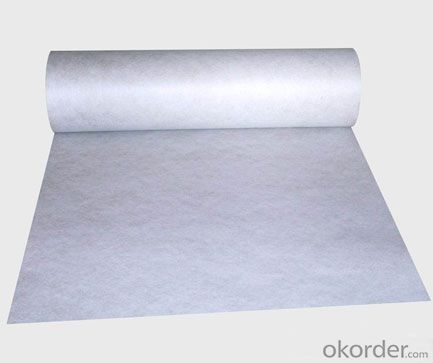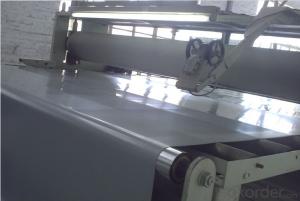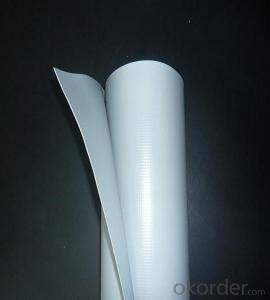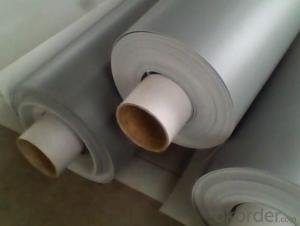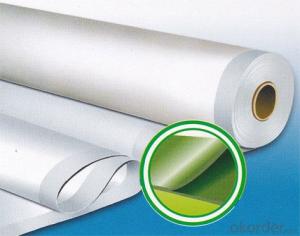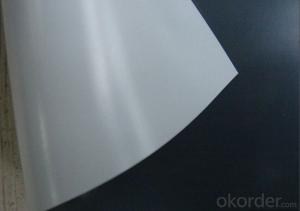PVC Resistant Waterproof Membrane with Fabric
- Loading Port:
- China main port
- Payment Terms:
- TT OR LC
- Min Order Qty:
- 1000 m²
- Supply Capability:
- 50000 m²/month
OKorder Service Pledge
OKorder Financial Service
You Might Also Like
Product Specification
name:High Quality PVC Waterproofing membrane
brand:Wanbao
width:2.05m
thickness: 1.2mm,,1.5mm,,2.0mm
Product Features
low -cost ,anti-aging ,anti -ultraviolet proformance ,shrinkage rate is high ,low temperature flexibility is good
Physical Property
1. Exposed to sunshine: UV rays resistance, long service life and aging resistance
2. Easy installation and dimensional stability: can be wieldable under wide range of temperature and experience minus dimensional change in thermal treatment
3. High tensile strength and elongation thus can accommodate movements of substrates
4.Good flexibility under low temperature, good adaptability to ambient temperature difference
5, Secure anti-puncture and good rooting resistance, no pollution caused to environment when being welded and good waterproofing choice for plant roofs
6. Good plasticity: convenient and fast treatment of detailed parts of corners and edges
Applicable scope
PVC sheet forms an effective barrier to liquid water or water vapor in the roof construction for industrial and civil engineering, underground engineering such as subway& tunnel, water conservancy such as water pools & ditch, shelter, grain depot, land filling, dyke, sewage treatment and basement.
Cautions
1. Do not put the membrane on a pollution, water and ice ground.
2. Construcion of waterproof layer operations can't be crossed, device shall be installed on the waterproof layer, parts should be done to strengthen the basis of device and to take protective measures.
3. Do not touch the waterproof layer with thorn sharp objects after it's has been completed, don't put sundries or any additional buildings above the waterproof layer to avoid damaging it.
FAQ of PVC Waterproofing Membrane
a.Can we get some samples before place order?
Answer: We can send the free samples to you by freight collect.
b.How many years can your PVC membrane guarantee?
Answer: We will guarantee the quality for 5 years at least.
c.Which countries you ever export the product?
Answer: We export the PVC membrane to South Africa, Middle east and even European countries.
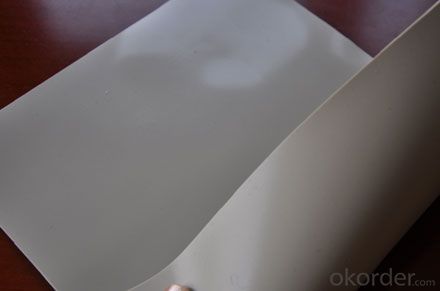
- Q: Can waterproofing membranes be painted over?
- Yes, waterproofing membranes can be painted over. However, it is important to ensure that the paint used is compatible with the membrane material. It is recommended to consult the manufacturer's guidelines or seek professional advice to ensure proper adhesion and longevity of the paint. Additionally, the surface should be clean and dry before applying the paint to ensure optimal results. Overall, painting over a waterproofing membrane can help enhance its appearance and provide additional protection against UV rays and other environmental factors.
- Q: Is a waterproofing membrane resistant to algae or moss growth?
- Yes, a waterproofing membrane is typically resistant to algae or moss growth. The materials used in waterproofing membranes are designed to prevent the growth of organic matter, including algae and moss.
- Q: Can a waterproofing membrane be used for wastewater facilities?
- Yes, a waterproofing membrane can be used for wastewater facilities. Waterproofing membranes are specifically designed to protect structures from water damage, including from wastewater. These membranes are typically made of durable materials such as PVC, EPDM, or TPO, which have excellent resistance to water and chemicals. Wastewater facilities require robust protection against the corrosive and potentially damaging effects of wastewater. Installing a waterproofing membrane can help prevent water infiltration, which can lead to structural damage, deterioration, and contamination of surrounding areas. Waterproofing membranes provide a barrier that prevents water and moisture from penetrating the facility's walls, floors, and foundations. This helps to maintain the integrity of the structure, prevent leaks, and protect against corrosion caused by chemicals present in wastewater. In addition to protecting against water and chemical damage, some waterproofing membranes also offer resistance to UV rays, high temperatures, and freeze-thaw cycles, which are important considerations for wastewater facilities located in extreme weather conditions. Overall, using a waterproofing membrane in wastewater facilities is a reliable and effective solution to ensure long-term protection against water damage, maintain the structural integrity, and enhance the durability of the facility.
- Q: What is the recommended temperature range for applying a waterproofing membrane?
- The recommended temperature range for applying a waterproofing membrane typically varies depending on the specific product being used. However, in general, it is advisable to apply the membrane within a temperature range of 50°F to 90°F (10°C to 32°C). This temperature range ensures optimal bonding and curing of the membrane, allowing for effective waterproofing. It is important to follow the manufacturer's instructions and guidelines for the specific product being used, as they may provide more specific temperature recommendations based on their formulation and application process. Additionally, it is crucial to consider the ambient temperature and conditions during application, as extreme temperatures or weather conditions can affect the performance and effectiveness of the waterproofing membrane.
- Q: Can a waterproofing membrane be used on precast steel surfaces?
- Yes, a waterproofing membrane can be used on precast steel surfaces. The membrane is designed to provide a protective layer against water penetration, making it suitable for application on various surfaces, including precast steel. This can help prevent corrosion and prolong the lifespan of the steel structure.
- Q: Can a waterproofing membrane be used in planters or garden beds?
- Planters or garden beds can benefit from the use of a waterproofing membrane. These membranes are typically made from moisture-resistant materials and effectively prevent water from seeping through. This is especially useful when the planter or garden bed is constructed from materials that are not naturally waterproof, like wood or concrete. By implementing a waterproofing membrane, you can safeguard against excessive water damage that can result in rotting, warping, or cracking. Moreover, the membrane can aid in retaining moisture within the planter or garden bed, creating an optimal environment for plant growth. Nevertheless, it is crucial to verify that the chosen waterproofing membrane is plant-safe and free from any harmful chemical release into the soil.
- Q: Can a waterproofing membrane prevent leaks from occurring?
- Yes, a waterproofing membrane can prevent leaks from occurring. A waterproofing membrane is a thin layer of material that is applied to a surface to make it completely impermeable to water. It acts as a barrier, preventing water from seeping through and causing leaks. When properly installed and maintained, a waterproofing membrane can effectively protect various structures such as roofs, basements, bathrooms, or foundations from water damage. It is designed to withstand the forces of nature, including rain, snow, and moisture, and can significantly reduce the risk of leaks and water infiltration. However, it is important to note that the effectiveness of a waterproofing membrane also depends on the quality of the product, proper installation, and regular maintenance.
- Q: Can a waterproofing membrane be used in conjunction with green building practices?
- Yes, a waterproofing membrane can definitely be used in conjunction with green building practices. In fact, incorporating a waterproofing membrane into the construction of a green building can help enhance its overall sustainability and efficiency. One of the key principles of green building practices is to maximize energy efficiency and reduce the environmental impact of a building. By installing a waterproofing membrane, the building's envelope can be protected from moisture intrusion, preventing water damage and potential mold growth. This, in turn, helps maintain the structural integrity of the building, reducing the need for repairs and replacements, which can be resource-intensive and generate waste. Additionally, a waterproofing membrane can contribute to better indoor air quality. By preventing water infiltration, it helps create a dry and healthy living or working environment, minimizing the risk of respiratory issues and other health problems associated with dampness. Furthermore, a waterproofing membrane can improve the energy efficiency of a building. By preventing water from seeping into the walls or foundation, it reduces the potential for heat loss through moisture evaporation, thus reducing the energy needed for heating and cooling. This can lead to reduced energy consumption and lower carbon emissions, aligning with the goals of green building practices. It is important, however, to choose a waterproofing membrane that is environmentally friendly and meets green building standards. Look for membranes that are made from recycled or sustainable materials and have low VOC (volatile organic compound) content. Additionally, consider selecting a membrane that is designed for durability and longevity, as this can further reduce the environmental impact by minimizing the need for replacement over time. In conclusion, a waterproofing membrane can be a valuable addition to any green building project. It helps protect the building envelope, improves indoor air quality, and enhances energy efficiency. By selecting an environmentally friendly membrane, the overall sustainability of the building can be further improved.
- Q: Can waterproofing membranes be used on roof decks?
- Indeed, roof decks can benefit from the use of waterproofing membranes. Specifically engineered to ward off water infiltration, these membranes prove to be an excellent option for safeguarding roof decks. Typically composed of materials like modified bitumen, thermoplastic, or rubberized asphalt, these membranes possess exceptional water resistance and possess the ability to effectively seal the surface of the roof deck. By applying a waterproofing membrane to a roof deck, it acts as a deterrent against water-related harm, leaks, and the decay brought about by moisture. Furthermore, these membranes can also provide extra defense against UV rays, temperature fluctuations, and other environmental variables, thereby prolonging the lifespan of the roof deck.
- Q: Are waterproofing membranes suitable for crawl spaces?
- Indeed, crawl spaces can be susceptible to moisture and water infiltration due to their positioning and inadequate ventilation. However, by implementing waterproofing membranes, one can effectively thwart water damage and issues arising from excessive moisture. These membranes are specifically engineered to establish a barricade against water and moisture, thereby preventing their intrusion into the crawl space and the subsequent development of problems like mold growth, decay, and structural deterioration. Moreover, the utilization of waterproofing membranes can contribute to enhancing the quality of indoor air by diminishing humidity levels in the crawl space. Consequently, it is strongly advised to employ waterproofing membranes in crawl spaces in order to guarantee a dry, sanitary, and healthful environment.
Send your message to us
PVC Resistant Waterproof Membrane with Fabric
- Loading Port:
- China main port
- Payment Terms:
- TT OR LC
- Min Order Qty:
- 1000 m²
- Supply Capability:
- 50000 m²/month
OKorder Service Pledge
OKorder Financial Service
Similar products
Hot products
Hot Searches
Related keywords
